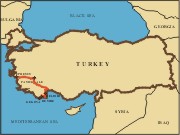
A TRIP ROUTE
INTERESTING FACTS
The Temple of Artemis in Ephesus, known as Artemision, was one of the Seven Wonders of the Ancient World. It was impressively 130 m long by 69 m wide, and it was built around 560 BC by King Lydia Croesus. The original statue of Artemis, unpreserved, was made of gold, silver, ivory, ebony wood, and black stone. In 356 BC the temple was burnt down by the shoemaker Herostrates in the hope that this act would immortal his name. The Artemision was rebuilt in the years 334 BC to 260 BC with contributions from the inhabitants of Ephesus. The last temple was destroyed during the Goth invasion in AD 262 and was never rebuilt.IT IS WORTH SEEING
According to medieval accounts, Mikołaj, who was the bishop of Myra, lived at the turn of the 3rd and 4th century AD in Lycia and became famous for many miracles and helping the poor and needy. For centuries he was one of the most revered saints in the West and East. In the iconography of St. Nicholas is depicted with a beard, in the robes of a Latin or Greek bishop, with a miter and a crosier. Most often he holds a book in one hand and a gesture of blessing with the other. Already in the Middle Ages, Nicholas was considered the patron saint of children. Modeled on it, the fairy-tale character of St. Nicholas is widely used in mass culture on the occasion of Christmas.Turkey - Turkish Riviera
July 2004
Holidays in Turkey were our first trip outside of Europe together. We took advantage of the tourist office's offer. It didn't all look like it was in the ad, but we didn't care too much about it. We used the beautiful weather, warm sea and the all inclusive offer in a modest little hotel in Beldibi on the Turkish Riviera.
As Beldibi does not have many attractions, we went on a couple of excursions arranged by the local travel agency. The quality of service was a lot to be desired, but it was cheaper than with us and the places visited were worth the trouble of the trip. I especially remember the boat trip to the sunken city of Kekova. During an offshore stopover to relax in crystal clear waters, I swam too far and couldn't find our ship. After an hour of sailing in the sea, a patrol boat from the Harbor Master's Office found me. Fortunately, it was scared, and as a punishment I had to dance solo to the rhythm of Turkish music on the ship.Beldibi
Beldibi is a typical tourist destination on the Turkish Riviera - one street along the beach and plenty of hotels and shops for tourists. The only things you could do there were sunbathing, swimming, eating and drinking. And this is how we spent our time using the all inclusive option. We managed to avoid the boredom of everyday activities, thanks to lovely friends who bravely keep us company during our rest.
Myra and Kekova
Ancient Myra is called Demre today. Picturesque rock tombs carved on the hillside made the greatest impression on us, but Myra's trademark is St. Santa Claus. Kekova, on the other hand, is a small island near Demre, famous for the ancient town of Dolchiste, which was sunken by an earthquake in the 2nd century AD. We could admire the ruins only from a boat, but we had to look closely to see all the ancient columns, sarcophagi, platforms and remnants of temples and houses under the sea surface, colorfully described in the guidebook.
Ephesus
The ruins of Ephesus are one of the most popular monuments on the tourist map of Turkey. Founded in the 6th century BC as a Greek colony, Ephesus fully deserved its fame. It was a wonderful experience to walk through the streets of this never-ending commercial city. The variety of facilities available is impressive - temples, gates, fountains, gymnasium, agora, odeeon, theater, library and even latrines. It was here that the famous temple of Artemis was located, of which, unfortunately, no trace has been left. The only thing that spoiled the pleasure of sightseeing was the fact that the batteries in the camera were empty.
Pamukkale
Pamukkale, or Cotton Castle, is famous for its limestone deposits formed on the slope of Cökelez Mountain. The water flowing out of the hot springs, cooling on the surface, precipitates calcium carbonate, the sediments of which create fanciful thresholds, terraces and pools. The view is amazing, and walking along the picturesque travertines we had the impression of treading on ice. The entire area has been included in the UNESCO Natural Heritage List. Water also has healing properties, which were appreciated in antiquity when the spa of Hierapolis was built nearby.
![]()
![]()
![]()
Your comments:




